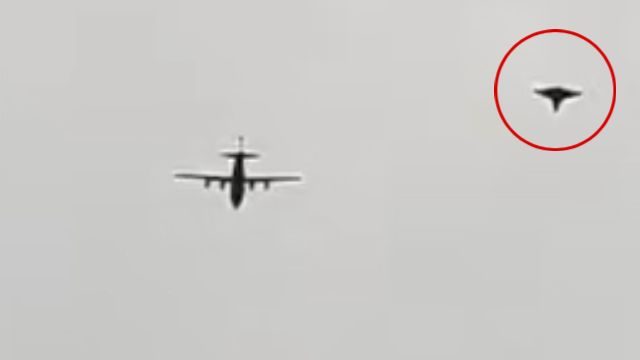
Summary
– China’s CCA UCAV marks a leap in stealth drone technology.
– Rapid development could outpace Western rivals.
– Potential mass production threatens regional power balances.
– New footage will reveal the CCA’s true combat potential.
For the first time, video footage has surfaced showing what appears to be China’s next-generation stealth UCAV—known unofficially as the CCA—flying in formation with a Y-8 or Y-9 transport aircraft.
Shared on the Chinese platform Weibo and highlighted by OSINT analyst @RupprechtDeino, the footage offers a rare glimpse of an active flight test, signaling that China may be entering the operational testing phase of its loyal wingman-style drone program. This development suggests a fast-moving effort by the PLA Air Force to integrate unmanned systems into its future combat doctrine.
What is China’s CCA UCAV?
The Collaborative Combat Aircraft [CCA], as it’s unofficially dubbed, represents a bold step in China’s push to modernize its air force with cutting-edge unmanned technology. Designed to operate as part of the People’s Liberation Army Air Force [PLAAF] future squadrons, the CCA is a stealthy unmanned combat aerial vehicle [UCAV] tailored for high-stakes missions.
Likely developed by AVIC’s Hongdu Aviation Industry Group, a powerhouse in China’s aerospace sector, the CCA boasts a flying-wing configuration, optimized for a low radar cross-section [RCS] to evade detection. Notably, the drone appears sleek, with no visible external sensors, enhancing its stealth profile.
The CCA’s primary role is expected to be that of a “loyal wingman,” a drone that works alongside manned aircraft, providing tactical support, data sharing, and enhanced situational awareness. Beyond this, analysts speculate the CCA is built for deep-strike missions, capable of penetrating enemy defenses, and Suppression/Destruction of Enemy Air Defenses [SEAD/DEAD] operations, targeting radar and missile systems.
Its versatility suggests China aims to integrate the CCA into complex, multi-layered combat strategies, amplifying the PLAAF’s operational reach. This first-ever footage of the CCA flying with a Y-8 or Y-9 transport aircraft underscores China’s rapid progress in unmanned systems, positioning the PLA as a formidable player in next-gen aerial warfare.
First appearance: context of the video
A short yet captivating video, posted by Weibo user @lyman2003, has ignited widespread interest among defense enthusiasts, revealing the first public sighting of China’s CCA UCAV soaring through the skies. This rare footage, swiftly amplified by @RupprechtDeino, a trusted OSINT analyst specializing in military aviation, shows the stealthy drone flying in tight formation alongside a Y-8 or Y-9 transport aircraft, a workhorse of the PLA Air Force.
The presence of the Y-8/Y-9, likely acting as a command or control hub, suggests this was no ordinary flight but a deliberate test of operational synergy. The pairing indicates that China is rigorously assessing the CCA’s ability to integrate with manned platforms, a cornerstone of modern networked warfare. This test likely evaluates how the drone communicates, shares real-time data, or executes coordinated maneuvers with its manned counterpart, paving the way for complex tactical scenarios.
The video’s appearance on Weibo, a platform often used for strategic leaks of China’s military advancements, raises questions about whether this reveal was intentional, signaling confidence in the CCA program.
Analysts see this as evidence of the PLA’s accelerating efforts to develop unmanned systems capable of enhancing combat effectiveness, from reconnaissance to precision strikes. As discussions swirl online, the footage underscores China’s ambition to redefine aerial warfare through integrated, autonomous capabilities, positioning the CCA as a key asset in future conflicts.
Role and purpose of the CCA in the PLA
China’s Collaborative Combat Aircraft [CCA] is poised to become a cornerstone of the People’s Liberation Army Air Force [PLAAF], designed to operate within an “intelligent swarm” framework that maximizes battlefield efficiency through networked, autonomous systems.
The CCA’s versatility positions it as a multi-role platform, capable of executing a range of high-impact missions. It is tailored for Suppression of Enemy Air Defenses [SEAD], engaging anti-aircraft systems to clear the way for manned aircraft. Additionally, the CCA can serve as a decoy, drawing enemy attention and fire away from piloted jets, thereby enhancing their survivability in contested environments.
Its stealthy design also supports surveillance and electronic warfare, enabling it to gather critical intelligence or disrupt enemy communications and radar. Furthermore, the CCA is likely equipped for target designation, guiding long-range missiles with precision to strike high-value assets deep in enemy territory. Control of the CCA is expected to come from advanced platforms like the J-20 stealth fighter or command aircraft such as the Y-8/Y-9, as seen in the recent footage.
This integration allows for seamless coordination, where the CCA acts as a force multiplier, amplifying the PLAAF’s tactical flexibility. By embedding the CCA into its doctrine, the PLA is crafting a future where swarms of unmanned systems reshape air combat, blending stealth, autonomy, and precision to dominate complex battlefields.
Comparison with Western equivalents
As China unveils its CCA UCAV, a natural comparison arises with Western counterparts, as outlined in the accompanying table. The Boeing MQ-28 Ghost Bat, part of Australia’s Loyal Wingman program under the Airpower Teaming System, serves the Royal Australian Air Force [RAAF] with a focus on supporting manned fighters. Similarly, the XQ-58A Valkyrie, developed by Kratos for the U.S. Air Force [USAF], emphasizes low-cost, reusable drones for combat roles.
On the Russian side, the S-70 Okhotnik-B, controlled by the Su-57, aligns with Moscow’s push for stealthy, long-range unmanned systems. Meanwhile, China’s CCA, potentially managed by the J-20 or Y-8/Y-9, fits into this global trend of integrating unmanned assets. However, the table highlights a striking contrast: the CCA’s emergence suggests a rapid development cycle, outpacing some Western programs that have faced delays due to rigorous testing and procurement hurdles.
China’s advantage lies in its swift progress, likely fueled by a decentralized production model leveraging satellite facilities across the country. This approach allows for parallel manufacturing and quicker iteration, giving Beijing a head start in fielding operational UCAVs. Yet, this speed comes with trade-offs. The CCA’s autonomy level remains shrouded in mystery, with no public data on its artificial intelligence or decision-making capabilities, unlike the more transparent testing phases of the MQ-28 or XQ-58A.
Additionally, the lack of open demonstrations limits global insight into its reliability and combat readiness. While China races ahead, these unknowns could hinder its ability to match the proven interoperability and trust Western allies have built into their systems, leaving analysts eager for more clarity as the CCA program evolves.
What we know about production and program status
The CCA UCAV’s journey from concept to flight has been pieced together through fragmented evidence, offering a glimpse into China’s secretive aerospace ambitions. The first hint of the program emerged in 2022, when satellite imagery captured a prototype at an undisclosed facility, sparking speculation among analysts.
A second prototype surfaced in 2023, suggesting steady progress and a commitment to refining the design. Strikingly, the program lacks an official designation, though experts link it to the broader “J-XY” initiative, potentially tied to China’s sixth-generation fighter development—a sign of its strategic importance to the PLA Air Force.
The recent video, showing the CCA alongside a Y-8/Y-9, marks a pivotal moment, indicating the program has entered an initial phase of tactical testing. This shift from static prototypes to active flight trials hints at a maturing project, though details remain scarce.
Production insights are equally murky, with Hongdu Aviation Industry Group or Chengdu Aerospace Corporation emerging as likely contenders, given their expertise in advanced aircraft. Hongdu’s track record with unmanned systems and Chengdu’s role in stealth technology make them prime candidates, though no official confirmation exists.
The rapid prototype rollout and early testing suggest a well-funded effort, possibly accelerated by China’s decentralized industrial base. However, the absence of public milestones or naming conventions keeps the program’s scope and timeline under wraps. As the PLA pushes forward, this footage could be a deliberate signal of confidence, yet the lack of transparency leaves the international community guessing about the CCA’s full potential and deployment readiness.
Tactical significance and future scenarios
The emergence of the CCA UCAV alongside a Y-8/Y-9 transport aircraft could herald a transformative shift in China’s military strategy, with far-reaching implications for modern warfare. If confirmed, this collaboration suggests the CCA is capable of real-time autonomous management, potentially controlled via the Y-8/Y-9’s advanced command systems.
This setup could enable a seamless “system of systems” combat network, where the UCAV integrates with manned assets, satellites, and ground stations to deliver coordinated strikes and intelligence. Such a capability would amplify the PLA Air Force’s operational flexibility, allowing it to adapt swiftly to dynamic battlefield conditions.
A likely future scenario involves small formations of 2–4 CCA drones, guided by a J-20 stealth fighter or a dedicated ground control center. These units could execute deep penetration missions, striking high-value targets far behind enemy lines, or suppression strikes to neutralize air defenses, clearing the path for follow-on forces.
The PLA’s focus on such tactics points to potential deployment in contested regions like the Taiwan Strait or the South China Sea, where rapid, decisive air superiority could shift regional power dynamics. Analysts suggest these scenarios align with China’s long-term goal of projecting force beyond its borders, leveraging the CCA’s stealth and versatility.
As testing progresses, the drone’s role in these theaters could redefine aerial combat, positioning China as a leader in unmanned warfare by the late 2020s, though its success hinges on overcoming technical and operational challenges yet to be revealed.
The next critical step
China’s unveiling of the CCA UCAV reflects its enduring strategy of “quiet development,” where progress unfolds behind closed doors until strategic moments demand visibility. This approach has allowed the PLA to nurture cutting-edge technologies like the CCA with minimal international scrutiny, positioning it as a potential game-changer.
Analysts suggest the CCA could outpace Western counterparts in sheer numbers and operational readiness, leveraging China’s vast industrial capacity to scale production rapidly.
Unlike the methodical, often delayed rollouts of programs like the MQ-28 Ghost Bat or XQ-58A Valkyrie, the CCA’s swift transition from prototypes to tactical testing hints at a readiness to deploy en masse, integrating seamlessly into real-world combat scenarios. This mass-production potential could see the CCA bolstering PLA operations across disputed regions, from the Taiwan Strait to the South China Sea, within the next decade.
The drone’s full capabilities remain speculative, but its stealthy design and synergy with platforms like the Y-8/Y-9 or J-20 suggest a versatile asset poised to reshape aerial warfare. Still, uncertainties linger around its autonomy, payload, and endurance.
The next critical step lies in monitoring fresh footage or leaks, which could clarify its configuration and intended role. As China tightens its grip on unmanned technology, the world watches closely, anticipating whether the CCA will redefine the balance of power or face unforeseen hurdles in its ambitious ascent.
***
Follow us everywhere and at any time. BulgarianMilitary.com has responsive design and you can open the page from any computer, mobile devices or web browsers. For more up-to-date news, follow our Google News, YouTube, Reddit, LinkedIn, and Twitter pages. Our standards: Manifesto & ethical principles.
How we confirmed this story:
- BulgarianMilitary.com cross-references open-source intelligence, including battlefield maps and geolocated footage, to confirm military movements and resource claims. We analyze official statements, expert insights from defense analysts, and economic data to ensure accuracy.
- Social media posts are scrutinized and validated against primary sources, such as government reports and on-the-ground accounts. Our rigorous process guarantees reliable, fact-based reporting.
Support BulgarianMilitary.com and help us stay free and independent.

